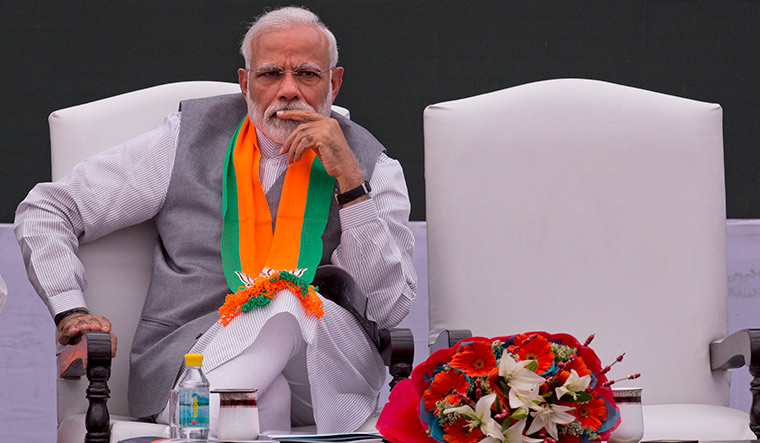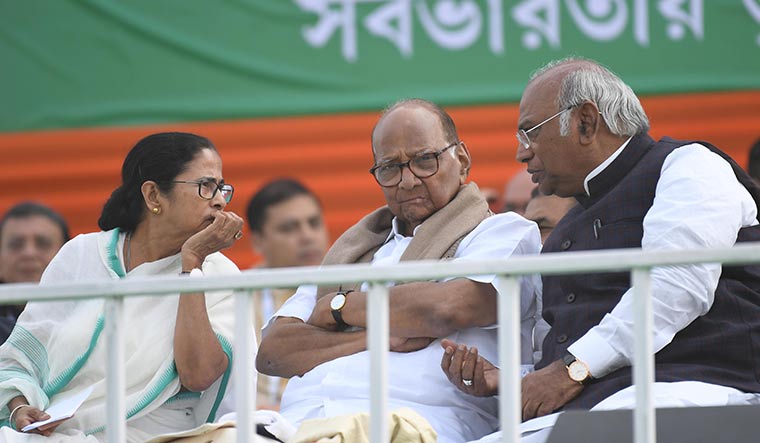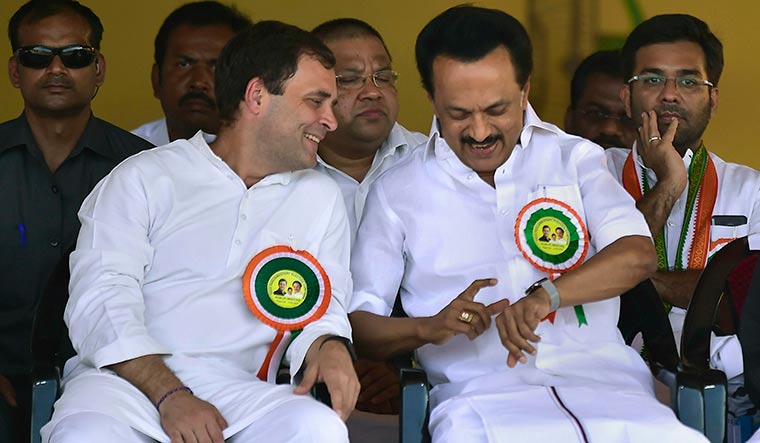K.Chandrashekar Rao is known to be a deeply religious man. So his five-day family trip to Kerala and Tamil Nadu that began on May 6, with visits to several temples on the itinerary, was hardly out of the way.
But it was not just faith that moved the Telangana chief minister; he had a political agenda as well. That became clear when, after visiting the Padmanabhaswamy Temple in Thiruvananthapuram, he called on Kerala Chief Minister Pinarayi Vijayan to seek the left front’s backing for his proposed federal front of non-BJP, non-Congress parties. On May 13, Rao flew to Chennai after visiting Sri Ranganathaswamy Temple in Tiruchirapalli, and met DMK president M.K. Stalin, whom he had been courting for a while. He also called Karnataka Chief Minister H.D. Kumaraswamy.
The federal front has been Rao’s pet project since March last year. He set about the task with renewed vigour soon after the fifth phase of the Lok Sabha elections ended, sensing that his Telangana Rashtra Samithi would do well in the elections, and that both the BJP and the Congress could fall well short of majority. With the seventh and final phase of the elections just days away, Rao intends to reach out to the Trinamool Congress in West Bengal, the Biju Janata Dal in Odisha and the mahagathbandhan of the Bahujan Samaj Party, the Samajwadi Party and the Rashtriya Lok Dal in Uttar Pradesh.
But Rao is too practical a politician to put all his eggs in one federal basket. He wants to be prepared for a range of scenarios that might emerge after the results are declared on May 23. His overtures to Kumaraswamy and Stalin, both of them Congress allies, could mean that he is not averse to supporting a Congress-led government—even though he once called Congress president Rahul Gandhi a “buffoon”. A famously flexible politician, he could even end up in the BJP-led National Democratic Alliance, as he seems to be in a tearing hurry to make his mark in Delhi.
“Rao has been saying all through the election campaign that his party would get two important Union posts,” said Telkapalli Ravi, a Hyderabad-based political analyst. “We have to understand what he meant: Whether it is the NDA, the UPA (the Congress-led United Progressive Alliance) or any coalition at the Centre, he would be in the government.”
But Rao knows that he is a small player in the national field. Telangana has just 17 Lok Sabha seats, and the TRS can hope for 16 seats at most. (It supports the All India Majlis-e-Ittehad-ul-Muslimeen in Hyderabad.) So how will Rao punch above his weight? Enter Y.S. Jaganmohan Reddy, whose YSR Congress Party is expected to do well in Andhra Pradesh, which has 25 seats.
Rao and Reddy are friends, thanks to a common enemy—Andhra Pradesh Chief Minister N. Chandrababu Naidu. Together, they are expected to win more than 30 seats, significantly improving Rao’s bargaining power. Reddy, whose interests are restricted to his state, has long been offering a blank cheque of political support to anyone who grants his big demand—the long-pending special category status for Andhra Pradesh.
Naidu, too, has busied himself with pre-verdict manoeuvres. He envisions himself as the facilitator of a grand, anti-BJP coalition, which will preferably have the Congress in the lead. On May 8, Naidu and Congress president Rahul Gandhi met in Delhi to discuss the need for opposition leaders to hit the ground running when the results come out. The next day, he flew to Kolkata to meet and campaign for West Bengal Chief Minister Mamata Banerjee, and said the “Bengal tigress” would play kingmaker in the next government. He is also in touch with Nationalist Congress Party president Sharad Pawar, a Congress ally, and BSP chief Mayawati and SP leader Akhilesh Yadav.
Both Rao and Naidu draw inspiration from the pivotal role that Telugu leaders have historically played in coalition politics. The National Front government was born in 1989 under the leadership of N.T. Rama Rao, Naidu’s father-in-law. Naidu himself was the convener of the United Front government formed in 1996, with H.D. Deve Gowda as prime minister. In 1998, Naidu’s lifeline helped Atal Bihari Vajpayee form the NDA government.
Naidu and Rao’s calculations largely depend on the BJP winning less than 200 seats and the Congress’s tally hovering around 100 seats—a scenario that would empower regional players like them. Naidu has spoken about having carried out surveys that say the NDA will not get a majority this time.
A split verdict would also boost the prospects of the left front and other non-aligned entities like the Trinamool in West Bengal, the BSP and the SP in Uttar Pradesh and the BJD in Odisha, as all of them could bag seats in the double digits. A senior opposition leader said regional parties in UP, Bengal, Telangana, Andhra Pradesh and Odisha alone could command some 140 seats.
“The discussion launched by Rao is a call to all regional parties to come together so that their bargaining power goes up,” said TRS leader B. Vinod Kumar. “It is not about who will be the next prime minister, or who is getting how many seats.”
But for regional leaders who have prime ministerial ambitions, the scenario is a dream—a 1996-like situation in which they can claim the big chair or demand their pound of flesh. Mayawati has already made her ambitions clear, telling supporters that if all goes according to plan, she might contest from the Ambedkar Nagar constituency in UP. Mamata’s campaign includes the slogan “Didi ebar Dilli jabe (Didi will now go to Delhi)”. Then there is Odisha Chief Minister Naveen Patnaik, who cannot be ruled out of the race, and Pawar, who reportedly still fancies his chances of becoming prime minister. Even Rao would rather be king than kingmaker.
In short, finding the numbers would not be as difficult as finding the prime minister. Which is why the Congress is feeling confident. “Our ally (Stalin) has already answered this question (on federal front plans),” said Congress spokesperson Randeep Surjewala. “Wishful thinking is all I can say about the idea of a third-front government coming into being. There is no doubt that a progressive, liberal, pro-democratic government led by the Congress will come to power.”
Doubts, however, are the reason that the Congress has gone soft on the BSP-SP-RLD mahagathbandhan in Uttar Pradesh, where it is locked in a triangular fight between the tri-party alliance and the BJP. The SP and the BSP have responded in kind, declaring support to the Congress in Amethi and Rae Bareli. “The main aim is to stop [Narendra] Modi and the BJP from returning to power,” said Congress leader Akhilesh Pratap Singh. “In this endeavour, all secular forces, including the BSP, the SP and the RLD are united.”
In West Bengal, the Congress has desisted from directly attacking Mamata. It has also engaged the left parties in talks, despite their indignation over Rahul contesting against their candidate in Wayanad in Kerala.
The talk of the NDA falling short of majority has pushed the BJP into fire-fighting mode. The party recently asked Rajnath Singh to call a media conference—his first at the BJP headquarters in Delhi since becoming Union minister. “I have toured the length and breadth of the country,” he said. “I have addressed 110 rallies and gauged the mood of the nation. I can say that the BJP is getting a massive majority.”
But the BJP, too, has been sounding out potential allies. In UP, the party tried to project itself as Mayawati’s well-wisher, with Modi warning her that Akhilesh Yadav was conspiring to keep her away from Lucknow. He also questioned her silence on the rape of a dalit woman in Rajasthan, asking her to withdraw support to the Congress government there. But, with Mayawati remaining belligerent, the BJP appears to be more interested in the SP now.
The BJP is also eyeing the TRS and the YSR Congress. In Odisha, where the party has made aggressive moves against the ruling BJD, Modi repeatedly praised the manner in which Patnaik mitigated the cyclone Fani. Patnaik wrote back thanking Modi for his prompt help, sparking off rumours about a possible tie-up. “Almost all opposition parties—the BSP, the Trinamool and the BJD—have engaged with the BJP in the past,” said a BJP leader. “Politics is the art of the possible.”
Abhay Kumar Dubey, of the Centre for the Study of Developing Societies, said Modi was preparing the ground to reach out to allies. “Modi said a very interesting line in an interview,” he said. “He said we have experience in running an alliance. It can be decoded to mean that he has doubts about the NDA getting a majority.”
There are BJP leaders who believe just that. “The BJP could lose seats in Madhya Pradesh, Rajasthan, Chhattisgarh, Jharkhand and Punjab,” said a senior leader. “The loss in these states can be compensated by gains in West Bengal, Odisha and the northeast. But the big test will be Uttar Pradesh; the seats lost there may not be compensated.”
Knives will be out for Modi and party president Amit Shah if the BJP fares poorly. Veterans who have been sidelined could take the duo to task, and the RSS would be in a position to make key decisions.
In terms of seats expected, the BJP’s worst-case scenario matches the Congress’s most optimistic one. The Congress’s internal surveys peg the party’s tally at anywhere between 120 and 140 seats. This means three options: Hard bargains with regional leaders to stake claim for the prime minister’s post; becoming part of a third-front government; or supporting such a government from the outside. The Congress is rooting for the first option, and preparing to react fast to the scenarios that might emerge on May 23.
The party’s ultimate aim would be to preempt the BJP’s moves to break up the opposition bloc through horse-trading. The lessons from Goa and Manipur are still fresh. The BJP had outsmarted the Congress in both the states in 2017 by forming the government despite having fewer numbers. The Congress struck back last year in Karnataka, where it moved swiftly to form the government with the Janata Dal (Secular), despite the BJP emerging as the single-largest party.
The Congress has entrusted senior leaders such as Ahmed Patel, A.K. Antony, Ashok Gehlot, Ghulam Nabi Azad, P. Chidambaram and K.C. Venugopal with coordinating with existing allies and reaching out to potential ones. Gehlot, who played a key role in the Karnataka coup, is reportedly tasked with winning over Mamata and Jaganmohan Reddy. He had been a good friend of Reddy’s father, the late Congress leader Y.S. Rajasekhara Reddy. Ahmed Patel has held talks with Sitaram Yechury of the CPI(M) and D. Raja of the CPI, and has reached out to the mahagathbandhan in UP. Allies Pawar and Gowda are in touch with Chandrashekar Rao.
Defence Minister Nirmala Sitharaman said the hectic parleys in the opposition camp would prove futile. “The way opposition leaders are going from pillar to post shows that they don’t have any positive agenda,” she said. “They just want to be ready if something drops from above.”
Indeed, much would depend on who is first allowed to drop in at the Rashtrapati Bhavan after May 23. There is speculation about the steps President Ram Nath Kovind would take in case of a split verdict. “There are all sorts of precedents for the president to consider,” said constitutional expert Subhash Kashyap. “In the past, a person who was not even a leader of a party was invited. And there have been instances when the leader of the single largest party was invited. Or, when a pre-poll alliance was invited first.”
When the 1989 elections threw up a split verdict, President R. Venkataraman set the precedent of inviting parties according to their parliamentary strength. Thus, he first invited Rajiv Gandhi, who declined the offer. Venkataraman then invited V.P. Singh, the leader of the second largest party, the Janata Dal.
In 1996, President Shankar Dayal Sharma set another precedent—of inviting the leader of the largest alliance. Vajpayee accepted Sharma’s invitation, but was forced to quit after 13 days. Sharma then invited leader of the next big alliance—Deve Gowda, who had the support of the Congress. In 1999, President K.R. Narayanan invited the leader of the largest pre-poll alliance, and asked for proof of the support of allies. Vajpayee was allowed to form the government after he presented Narayanan with the requisite letters.
Kovind could invoke any of these precedents. Or, as Kashyap pointed out, he could stick to the recommendations of the Sarkaria commission, formed in 1983 to examine and rework legislative and constitutional matters. The commission said the largest pre-poll alliance should be invited first, followed by the single largest party, and then by the largest post-poll alliance.
Ultimately, it all boils down to two things: How the Indian voters dealt their cards, and how the leaders put their cards on the table.




